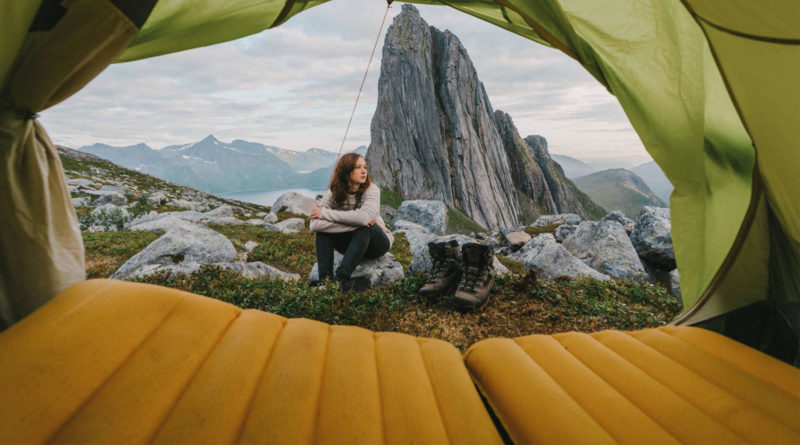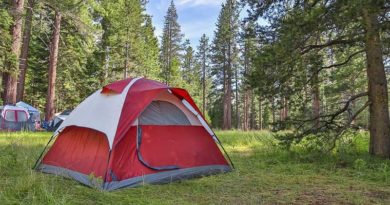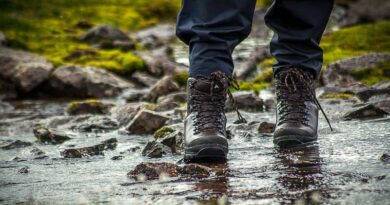Mummy vs. Rectangular Sleeping Pads: A Comparison
If you are getting a new sleeping pad and wondering what shape to get, keep reading because, in this article, I am going to explain the difference between mummy and rectangular shapes in terms of weight, comfort, and sleeping area. Mummy pads are primarily designed to be lightweight as they taper toward the feet which saves some weight. Less weight also means it will pack down small and can save some space in your backpack for your other gear. However, less weight and pack size also mean there will be less sleeping area at the end of the day. So, if you are a person who hates feeling restricted during slumber, a rectangular pad may be a better option for you.
A rectangular pad, on the other hand, provides more area for sleeping but it weighs more and takes up a lot of space in the backpack. It may cost roughly five ounces more with a traditional rectangular pad but you will also have more room to spread out at night. Another thing about the rectangular shape is that there’s less chance of falling off of your pad. If you tend to move around at night, get a rectangular pad because you could slide off of it into your buddy’s lap. However, there are some DIY techniques to attach your pad to your sleeping bag to minimize this problem.
Mummy Sleeping Pads
Shape: Mummy pads are designed to match the contours of a mummy-shaped sleeping bag, which typically tapers towards the feet. The mummy shape helps reduce unnecessary weight and bulk while providing insulation where it’s needed most.
Weight and Size: Generally, they tend to be more compact and lightweight compared to their rectangular counterparts. The design is optimized for backpackers and campers who prioritize minimizing weight and pack size.
Versatility: Suited primarily for users with mummy-shaped sleeping bags. These pads may not be as versatile when used with different sleeping bag shapes or for non-traditional sleeping positions.
Insulation Efficiency: Due to their tailored shape, they are often more efficient in providing insulation, especially in critical areas like the torso. This can be beneficial in colder conditions where heat retention is crucial.
Cost: These pads are often designed with lightweight materials and specialized shapes. This makes them more expensive compared to rectangular pads.
Rectangular Sleeping Pads
Shape: They have a consistent width from top to bottom. This shape offers more space for movement and can be preferred by those who find mummy-shaped pads too restrictive.
Weight and Size: These pads may be bulkier and heavier due to their larger surface area. They are often chosen by campers who prioritize comfort over weight savings or those who camp in less weight-sensitive situations.
Versatility: Their shape allows for more flexibility in terms of use. They can be comfortably used with a variety of sleeping bag shapes. They are also suitable for use outside of sleeping bags, such as for lounging or as a makeshift seat.
Insulation Efficiency: While still providing insulation, the consistent width of rectangular pads may not be as thermally efficient as mummy pads. However, for warmer weather or less extreme conditions, this difference may be negligible.
Cost: Generally, they tend to be more budget-friendly. They are a popular choice for campers who prioritize cost-effectiveness and are willing to trade off some features for affordability.
Big Agnes Air Core Ultra: A Rectangular Option
Weight: 1 lb. 2 oz.
Thickness: 3.5 in.
R-Value: 1.4
Dimensions: 72 x 20 in.
Big Agnes Air Core Ultra is designed primarily for summer or warm-weather backpacking. It inflates and deflates easily, weighs just over a pound, and packs down small to take up very little space in your pack. The pad utilizes a double ripstop nylon base fabric that helps to maintain that overall lightweight construction but also has excellent durability. The I-beam construction on the vertical baffles maintains the overall lightweight construction and gives this pad a 3.5-inch thickness. The outside baffles are slightly larger so when these are inflated, that helps to stabilize you on the pad and also kind of keeps you in place during the night so that you’re not rolling off of the pad.
Because it’s an inflatable pad, you do need to blow it up. There’s an innovative dual valve that Big Agnes has integrated into the pad, which makes inflation and deflation easy. The valve is one-way and does not allow air to escape even when it is opened. But when you blow it, the valve takes air easily and holds it well. There is also a little push tab that you can use to fine-tune the thickness or the firmness. The second valve is the deflate valve. Once you pop that, you will hear air rush right out of the pad. This makes it quick and easy to roll this pad back up and get on your way.
What I like: A lightweight and low-volume option for backpacking. It provides a good sleeping area and comes at an affordable price tag.
What I don’t: A little noisy, valves are not durable or high-quality
See the Big Agnes Air Core Ultra
Therm-a-Rest ProLite Plus: A Mummy Option

Weight: 1 lb. 7 oz.
Thickness: 1.5 in.
R-Value: 3.2
Dimensions: 72 x 20 in.
Therm-a-Rest ProLite Plus sleeping pad strikes a great balance between comfort, durability, and packability. The ProLite Plus isn’t your average self-inflating pad. Most pads with foam inside are comfortable but they’re too bulky and heavy to backpack with. Therm-a-Rest solves this issue by strategically cutting (diagonal-cut) the foam core to make it comfortable when inflated but packable to a small size. When fully topped off, the ProLite Plus measures 1.5 inches thick so it’s comfortable even for most side sleepers. It has an R-value of 3.2 so it’s appropriate for 3-season use.
The WingLock valve system is a fantastic easy-to-use method for inflating and deflating the pad. Simply twist the valve cap to let the foam soak up air. After the pad is finished self-inflating, you can top it off with a few breaths for maximum firmness then twist the valve lock closed. When you’re ready to break camp, simply twist the WingLock open then open the valve cap and roll the pad up from the bottom pushing the air out as you go. This valve technology is dependable, easy to use, and easy to replace. The pad includes a stuff sack for easy packing and is available in a few different sizes.
What I like: Self-inflating, affordable
What I don’t: Pack size, thickness, and weight can’t compete with an air pad.
See the Therm-a-Rest ProLite Plus
Summary
| FEATURE | MUMMY | RECTANGULAR |
|---|---|---|
| Comfort | Comfortable if you don’t toss and turn during the night | Very comfortable |
| Pack size | Packable | Not very packable |
| Weight | Lightweight | A little heavy |
| Sleeping area | Compromised due to weight savings | Good sleeping area |
| Versatility | Less versatile | Versatile, can be used for different outdoor adventures |
| Warmth | Average warmth | Warm |
| Best use | Backpacking, UL backpacking | Camping, car camping and winter camping |
Which one is right for you?
If you are an ounce-counting backpacker whose main concern is weight, get a mummy pad as it will save some weight and space in your backpack. A mummy pad also packs down small. Also, if you are a side sleeper and don’t toss and turn around at night, a mummy pad is going to work fine for you. On the other hand, if you are a comfort-minded or active sleeper, always choose a rectangular shape as it will provide more space and a comfortable night’s sleep. Rectangular pads also work great for back and stomach sleepers because your forearms/hands will most likely be off the pad with a mummy shape.
Never use a mummy pad for winter camping because you can easily reach the edge where insulation ends and the cold ground begins. Mummy pads also lack insulation compared to their rectangular counterparts. A traditional rectangular pad is always a good idea for winter camping because they are wider and provides more insulation from the cold ground.





